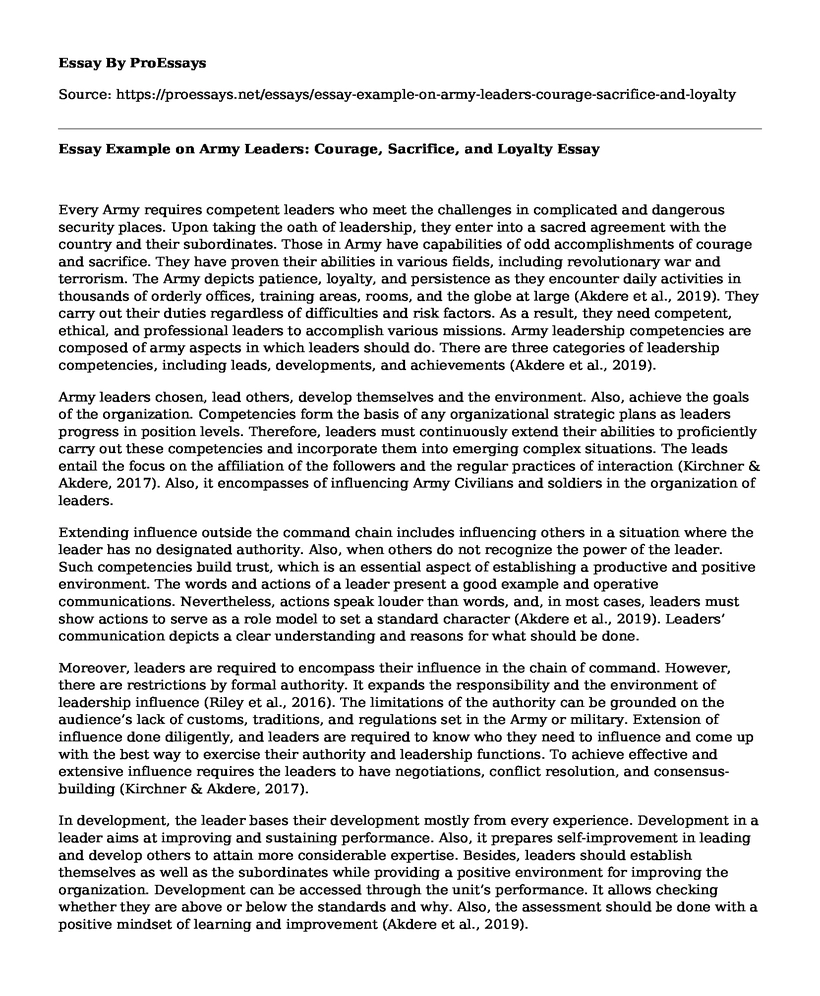Every Army requires competent leaders who meet the challenges in complicated and dangerous security places. Upon taking the oath of leadership, they enter into a sacred agreement with the country and their subordinates. Those in Army have capabilities of odd accomplishments of courage and sacrifice. They have proven their abilities in various fields, including revolutionary war and terrorism. The Army depicts patience, loyalty, and persistence as they encounter daily activities in thousands of orderly offices, training areas, rooms, and the globe at large (Akdere et al., 2019). They carry out their duties regardless of difficulties and risk factors. As a result, they need competent, ethical, and professional leaders to accomplish various missions. Army leadership competencies are composed of army aspects in which leaders should do. There are three categories of leadership competencies, including leads, developments, and achievements (Akdere et al., 2019).
Army leaders chosen, lead others, develop themselves and the environment. Also, achieve the goals of the organization. Competencies form the basis of any organizational strategic plans as leaders progress in position levels. Therefore, leaders must continuously extend their abilities to proficiently carry out these competencies and incorporate them into emerging complex situations. The leads entail the focus on the affiliation of the followers and the regular practices of interaction (Kirchner & Akdere, 2017). Also, it encompasses of influencing Army Civilians and soldiers in the organization of leaders.
Extending influence outside the command chain includes influencing others in a situation where the leader has no designated authority. Also, when others do not recognize the power of the leader. Such competencies build trust, which is an essential aspect of establishing a productive and positive environment. The words and actions of a leader present a good example and operative communications. Nevertheless, actions speak louder than words, and, in most cases, leaders must show actions to serve as a role model to set a standard character (Akdere et al., 2019). Leaders’ communication depicts a clear understanding and reasons for what should be done.
Moreover, leaders are required to encompass their influence in the chain of command. However, there are restrictions by formal authority. It expands the responsibility and the environment of leadership influence (Riley et al., 2016). The limitations of the authority can be grounded on the audience’s lack of customs, traditions, and regulations set in the Army or military. Extension of influence done diligently, and leaders are required to know who they need to influence and come up with the best way to exercise their authority and leadership functions. To achieve effective and extensive influence requires the leaders to have negotiations, conflict resolution, and consensus-building (Kirchner & Akdere, 2017).
In development, the leader bases their development mostly from every experience. Development in a leader aims at improving and sustaining performance. Also, it prepares self-improvement in leading and develop others to attain more considerable expertise. Besides, leaders should establish themselves as well as the subordinates while providing a positive environment for improving the organization. Development can be accessed through the unit’s performance. It allows checking whether they are above or below the standards and why. Also, the assessment should be done with a positive mindset of learning and improvement (Akdere et al., 2019).
Conclusion
Finally, achieve competency relates to the actions of accomplishing tasks and missions (Riley et al., 2016). The entire process involves providing value towards thriving in a given mission. Achieving the results is every leader’s goal. However, leaders should be aware that leadership and the provision of a positive environment help them work as successful leaders. Leaders can achieve through the right level of delegation, trust, and empowerment balanced against the mission. Important elements such as adaptability and adjustments to conditions based on adversarial actions are crucial in any mission (Riley et al., 2016).
References
Akdere, M., Hickman, L., & Kirchner, M. (2019). Developing leadership competencies for STEM fields: The case of Purdue Polytechnic Leadership Academy. Advances in Developing Human Resources, 21(1), 49-71. https://doi.org/10.1177/1523422318814546
Kirchner, M., & Akdere, M. (2017). Military leadership development strategies: implications for training in non-military organizations. Industrial and Commercial Training. https://doi.org/10.1108/ICT-06-2017-0047
Riley, R. P., Cavanaugh, K. J., Fallesen, J. J., & Jones, R. L. (2016). 2015 Center for Army Leadership Annual Survey of Army Leadership (CASAL): Military Leader Findings. Cubic Applications, Inc. Leavenworth United States. https://apps.dtic.mil/dtic/tr/fulltext/u2/1045842.
Cite this page
Essay Example on Army Leaders: Courage, Sacrifice, and Loyalty. (2023, Aug 08). Retrieved from https://proessays.net/essays/essay-example-on-army-leaders-courage-sacrifice-and-loyalty
If you are the original author of this essay and no longer wish to have it published on the ProEssays website, please click below to request its removal:
- Managing the Impacts of Change Paper Example
- Financial Crisis of a Community Health Center - Paper Example
- Research Paper on Tesco Company, Its Stakeholders, Their Corporate Governance, Environmental and Social Review
- Essay Example on Leaders: How to Choose the Right Decision-Making Model
- Essay Sample on Leadership Skills for Volatile, Uncertain, Complex and Ambiguous Organizations
- Essay Example on Activity-Based Costing: Enhancing Production Chain Efficiency
- Essay Example on Leadership Theory: Situational Leadership in Imagined Organisation







